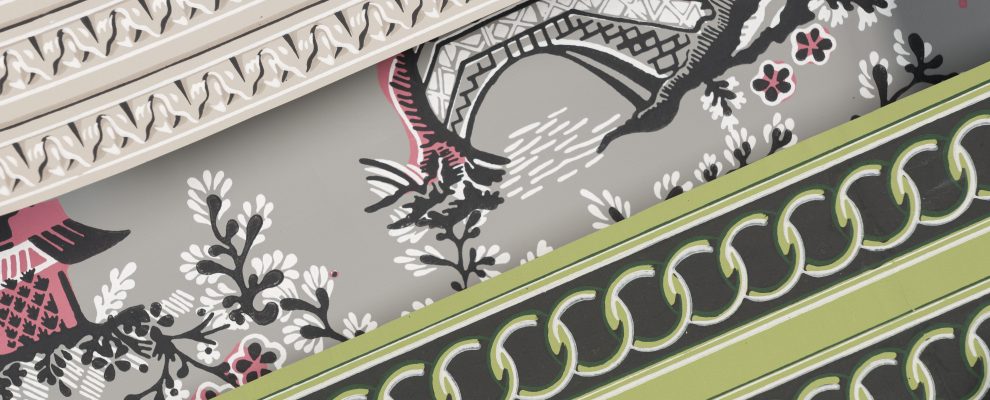Papers, paint, damask fabrics, decorative borders, tassels, fringing, bed hangings, curtains and rugs: opportunities for elevating one’s house beyond mere architecture, and enhancing it with beauty, comfort and fashionability were endless. The choices that lay before a wealthy Georgian homeowner were as plentiful as the array of shops, manufacturers and craftsmen willing to fulfil their furnishing needs.
Historian Amanda Vickery notes in Behind Closed Doors: At Home in Georgian England, that wallpaper became increasingly popular in the eighteenth century. By 1785 wallpaper consumption had increased tenfold in the previous 70 years. By that point consumers purchased more than two million yards a year. Papers, whether hand-painted and imported from the Orient or printed in England, provided a rich variety of striking patterns, bright and vibrant colour and rich texture for the walls. Homeowners and retailers alike found wallpaper’s different price points advantageous. The highest quality was suitable for furnishing the grandest of houses, and yet the genteel and middling ranks were still had a range of affordable papers to purchase. Wallpaper also enabled rapid and frequent renovations to keep up with changing fashions.
The ultimate expression of luxury and opulence, however, was silk damask fabric. Whereas a turnover of wallpaper was comparatively affordable, damask or velvet coverings were considered a considerable investment. The height of fashion was seen in rooms where such fabrics covered both the walls of a principle room and upholstered the suite of furniture within it. In these rooms gilded borders moulded or carved into elegant forms, created an impression of seamless riches and opulence as they concealed tacks and fixings that held the fabric in place.
The process of equipping Anne Fairfax’s newly rebuilt house on Castlegate with soft furnishings of a quality and luxury suitable for this finest of townhouses began in 1763. The Fairfaxes turned to the local family firm of Reynoldson’s to furnish and equip their new townhouse from top to bottom in the latest style. This was no doubt a valuable commission for Reynoldson’s both monetarily and in attracting other customers. The Fairfaxes chose flock wallpaper in a variety of colours for many rooms. Anne’s own chamber was given a highly fashionable ‘Mock India’ paper advertised on trade cards leading London wallpaper suppliers.
Further reading:
Amanda Vickery, Behind Closed Doors: At Home in Georgian England, Yale University Press, 2009.
Further links:
Temple Newsam wallpaper collection: www.leeds.gov.uk/museumsandgalleries/Pages/Temple-Newsam.aspx – Temple Newsam has one of the most extensive collection of historic wallpapers outside of the V&A, as well as paintings, furniture, silver, ceramics and textiles.
Whitworth Art Gallery www.whitworth.manchester.ac.uk/collection/ourcollection/wallpaper/ – searchable database of historic wallpaper.

Source: Consuming Passion: Shopping for Luxury in Georgian Britain (Fairfax House, 2015)
